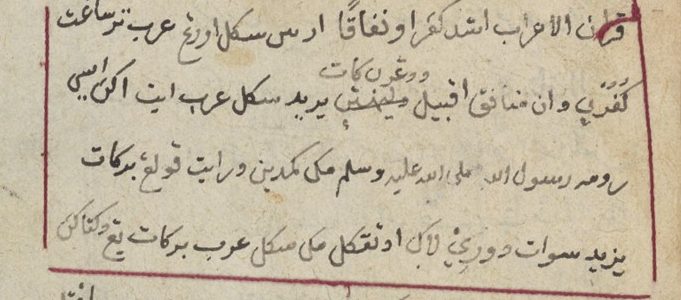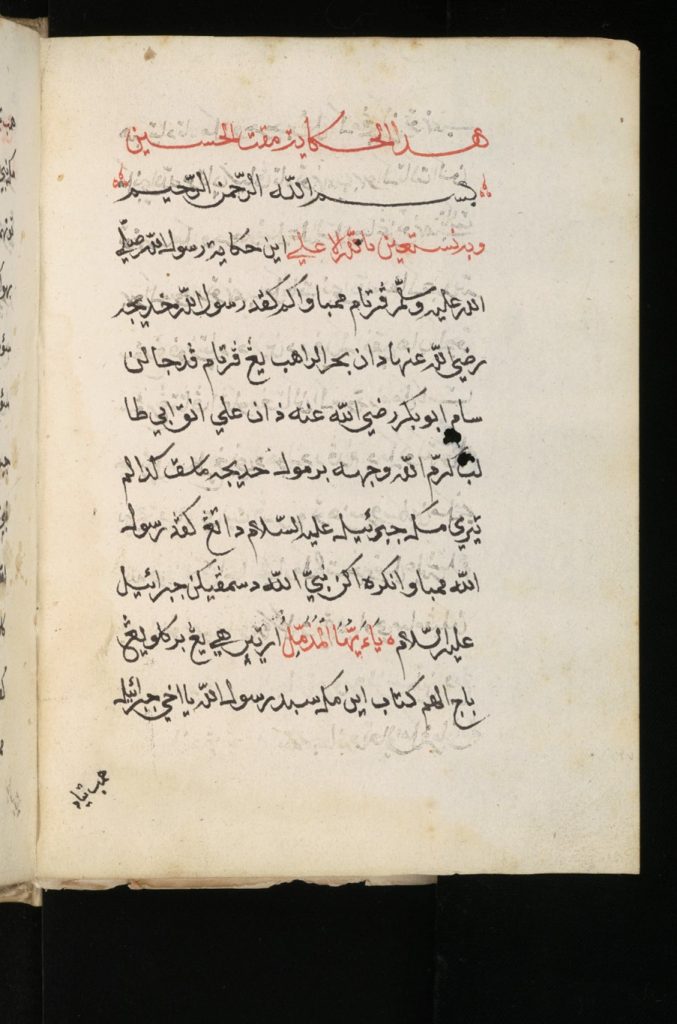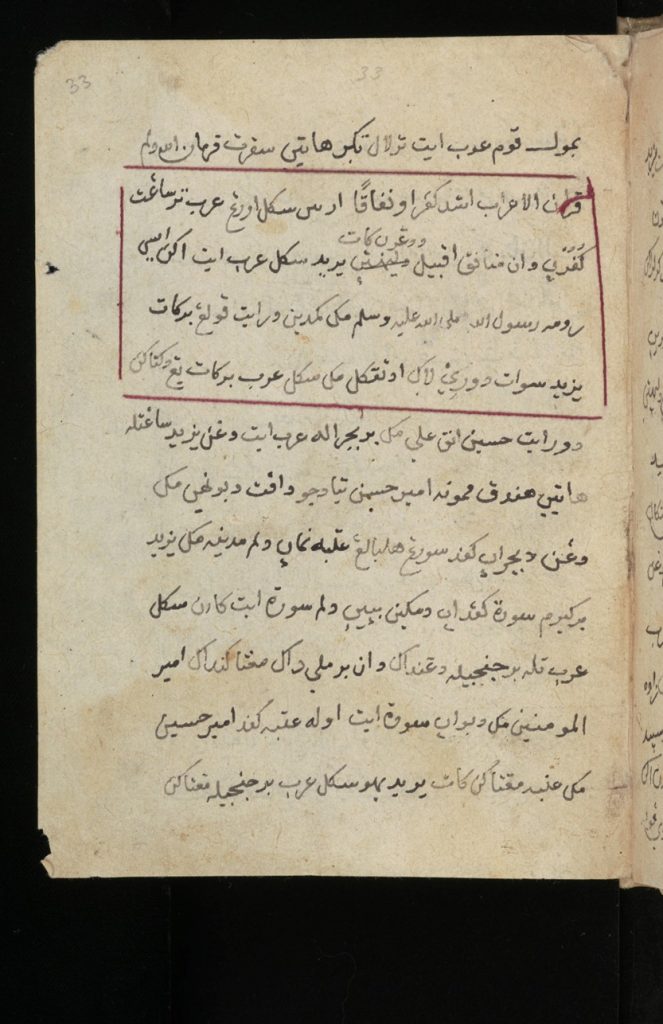
Secrets of the Erpenius copy of the Killing Story of Husain in Karbala
This post is by Munby Fellow Dr Majid Daneshgar, whose project for 2022/23 is entitled Revisiting Malay Islamic Manuscripts in the Cambridge University Library: Global Impact of the Erpenius Collection.
Content warning: This blog post is about a very old Malay Islamic folk story (hikayat) which includes racist comments about Black people and a particular Arab community; the post also contains a reference to a 17th-century manuscript note in Latin referring to the Prophet Muhammad as the “pseudo-prophet”. The researcher who has written the blogpost refers to this language in the post as evidence that can be used to re-appraise the origin, date and provenance of a Malay manuscript and its contribution to the transregional study of Islam from the Middle East and Central Asia to the Malay-Indonesian world.
Almost all the Malay-Indonesian manuscripts of the famous Dutch scholar and Arabist of Leiden, Thomas Erpenius at Cambridge University Library (henceforth: CUL) are the oldest extant of their type in the world. Having been housed in CUL since summer 1632, they are a valuable source of knowledge about the history of south and south-east Asian sources. One of the oldest manuscripts is MS Ll.6.5 which contains the “Killing Story of Husain” in 60 folios. The Erpenius copy of this text includes particular features which have not been examined before.[1] The text tells of the death of Husain, Muhammad’s grandson, at the hands of the army of the Umayyad ruler, Yazid, in Karbala (Iraq) in the year 680 CE. The story reaches its emotional peak when Husain’s half-brother, Muhammad b. al-Hanafiyyah, emerges as his avenger. Previous studies have demonstrated that this Malay story and its variant copies were based on a Persian prototype dating back to the 13th and early 14th century,[2] which “coincides precisely with the reign of the Turkic dynasty”.[3]
An inscription in the manuscript added after Erpenius’ death and its donation to CUL — highly likely by Abraham Wheelock (d. 1653), a Professor of Arabic language at the University of Cambridge and reflecting European Christian prejudices of the period — describes it as a ‘Turkic tract about the pseudoprophet Muhammad’:
Tractatus Turcicus de pseudo-propheta Mahumed
CUL MS Ll.6.5, fol. 1r
When this manuscript was still in Leiden, it was known only as an “Indian work” in the Malaccana language (i.e. Malay) using Arabic script, entitled “حکایة مقت الحسین”, meaning “the Killing story of Husain” which was taken from the heading of the story in Arabic script: “هذا الحکایة مقت[4] الحسین” (fol.4r). However, its over-emphasis on stories of Muhammad and earlier Muslim caliphs could be the main reason that prompted Wheelock to identify it as a story about Muhammad, the Prophet.

Folios 1r-25r tell the story of Muhammad and the caliphs and are written in a local Malay hand, like other copies of this story found in different libraries. These folios are placed under the header “P2” (Part II), suggesting that they were previously part of another book.
Nonetheless, the rest of the text (ff. 25v-60r), apart from the last page, is copied on a very different paper in a different hand and ink with a new header, “P1” (Part I), which confirms that it was also once part of another manuscript. The handwriting is mixed, giving the impression that it was copied in the late 15th or early 16th century by a scribe who may well have had some Turkic background. It is well-known that Turkic people were active throughout Persianate Central and South Asia at that time. The suggestion that the two parts did not originally belong together has been confirmed in consultation with experts in CUL’s Conservation and Collection Care department. Also, “P1” (Part I), with Turco-Malay handwriting, seems much older and includes features which are not found, to my knowledge, in any other Islamic materials.
Racist content
Folio 33r includes a Persian couplet, with its Malay rendition, ascribed to the Persian poet Ferdowsi (d. 11th century CE), who produced the Shah-namah (the Book of Kings). The theme of this couplet is: “Nothing good can be expected of a bastard, no more than a Black man can wash himself white.”[5] This racist couplet is followed by a verse from the Qur’an (Q 9:97) which says that “The desert Arabs are the most stubborn of all peoples in their disbelief and hypocrisy”. The placement of these quotations, intentionally selected by the scribe or main author of the story, demonizing Black people and “the nomadic/desert Arabs around Medina”[6] is linked with the following phrase in the story:
When Yazid had made himself sure of the hatred of the Arabs for the house of the Prophet he said: “Still one thorn is left: Husain the son of Ali!” Thereupon the Arabs deliberated with Yazid about the best way to kill Husain.[7]
CUL MS Ll.6.5, fol. 33r
Here, two points are striking:
First, this note regarding the “desert Arabs” is given a frame of red cotton stitching, which, as far as I am aware, is a unique form of using thread in Islamic manuscripts. This thread, according to my discussion with the Library’s conservators, was likely to have been added before the manuscript’s arrival at Cambridge, as the impression of the thread is obvious on the opposite page, suggesting that it was present while the manuscript was being bound in England with a cover identical to other old manuscripts in CUL.

Second, in most copies of the killing story of Husain, especially those produced after the 17th century, the whole section, including the couplet of Ferdowsi and the Qur’anic verse, are clearly omitted (e.g., the British Library MSS Malay D 5, fol. 37r and Malay B 6, fol. 68r). And this omission is not accidental: over the course of history, the whole story is censored throughout the Middle East and Central Asia, using different techniques and strategies, as I have discussed in my previous studies.[8] It may be that the red thread was added by a later user to highlight this passage as an indication to a copyist that it should be omitted.
Based on the above evidence, and further orthographic aspects of this part of the manuscript (that is, its Malayized Persian), it is evident that the two parts of this manuscript did not originally constitute a single unit but were joined at a later point. The second part, covering ff. 25v-60, is older and provides valuable evidence of a period when Persian literature and poems, particularly those of Ferdowsi, were read and copied in the Malay-Indonesian world. Further support for the transmission of Persian sources, probably originating with Turkic-Turkish travellers and visitors, comes from the presence of epigraphic inscriptions in Persian (including quotations from Ferdowsi) found on 15th-century tombstones in Indonesia. It seems to be during the same period that elements from these sources also found their way into Malay-Indonesian folk stories.[9]
In this regard, CUL MS Ll.6.5 (ff. 25v-60) can be considered as the oldest known copy of the killing story of Husain based on a Persian prototype. This Erpenius manuscript itself seems to have been used by the 16th-century scribe of MS 3.2.10 [MS 219] of Emmanuel College in Cambridge, due to its similarities and a further number of Persian couplets and quotations. This will be demonstrated in my forthcoming study.
[1] Further orthographic aspects of this story are discussed in the works of Ph S. van Ronkel, “Het Cambridge-Handschrift Ll. 6. 5 En Het Leidsche Handschrift der Hikayat Mohammed Hanafiyya,” Bijdragen tot de Taal-, Land-en Volkenkunde van Nederlandsch-Indië 1ste Afl (1896): 54-62; Richard Winstedt, “A History of Classical Malay Literature,” Journal of the Malayan Branch of the Royal Asiatic Society 31, no. 3 (183) (1958): 3-259; L. F. Brakel, The Story of Muhammad Hanafiyyah (Leiden, Koninklijk Instituut Voor Taal-, Land- en Volkenkunde, 1977); L. F. Brakel, The Hikayat Muhammad Hanafiyyah: A Medieval Muslim-Malay Romance (Berlin: Springer, 1981); and Majid Daneshgar, “New evidence on the origin of the Hikayat Muhammad Hanafiyyah,” Archipel. Études interdisciplinaires sur le monde insulindien 96 (2018): 69-102.
[2] Brakel, Ibid; Daneshgar, Ibid.
[3] Vladimir Braginsky, The Turkic-Turkish Theme in Traditional Malay Literature: Imagining the Other to Empower the Self (Leiden: Brill, 2015), p. 12.
[4] Although van Ronkel assumed that this may possibly be “Mukti” referring to a Sanskrit form of the “killing story”. Ph S. van Ronkel, “Account of Six Malay Manuscripts of the Cambridge University Library,” Bijdragen tot de Taal-, Land-en Volkenkunde van Nederlandsch-Indië 1ste Afl (1896): 1-53 (esp. p. 43).
[5] Brakel, The Story of Muhammad Hanafiyyah, 1977, p. 34. This English translation is based on the common version through the works of van Ronkel and Brakel among others.
[6] Both Saheeh international translation and Abdul Halim’s translation of the Qur’an are taken into account. See www.quran.com
[7] Brakel, Ibid.
[8] See Daneshgar 2018.
[9] About the Persian inscription in Indonesia, see: Majid Daneshgar, Gregorius Dwi Kuswanta, Masykur Syafruddin, and R. Michael Feener. “A 15th-Century Persian Inscription from Bireuen, Aceh: An Early ‘Flash’of Sufism before Fanṣūrī in Southeast Asia.” In Malay-Indonesian Islamic Studies: A Festschrift in Honor of Peter G. Riddell, edited by Majid Daneshgar and Ervan Nurtawab (Leiden: Brill, 2022), pp. 86-105. And on the influence of Turkic literature, see Braginsky 2015.
